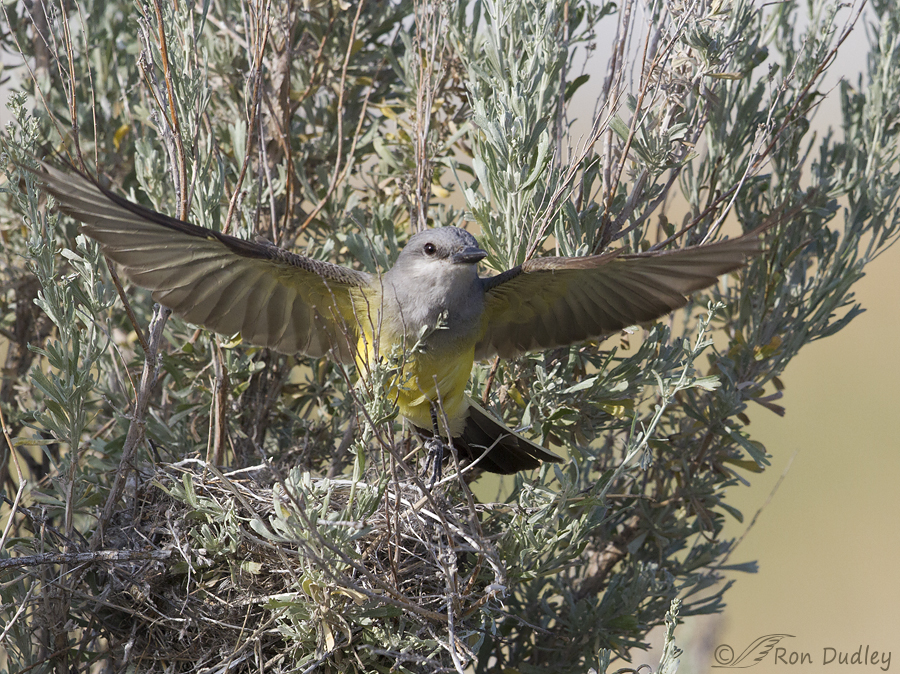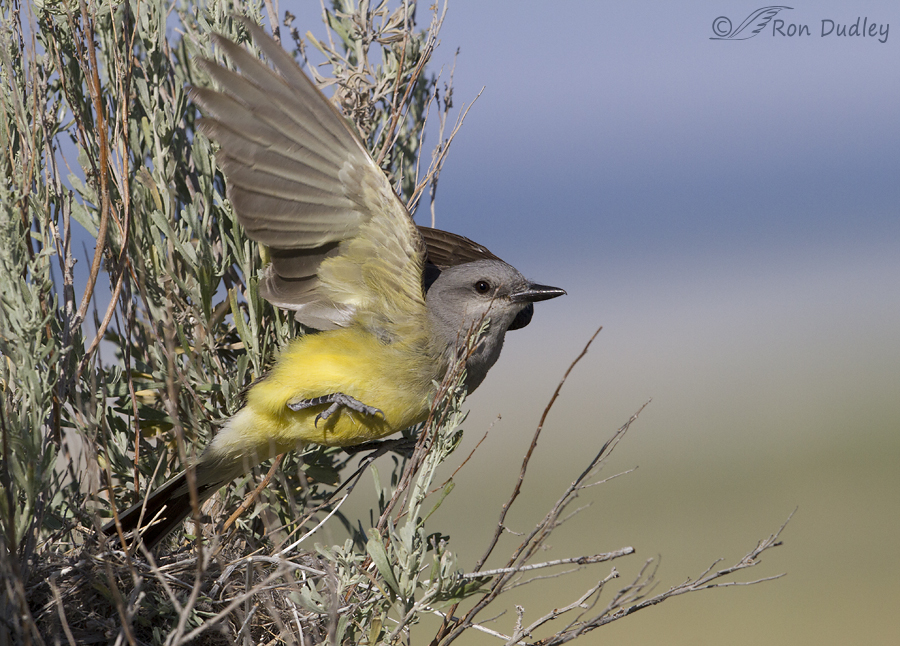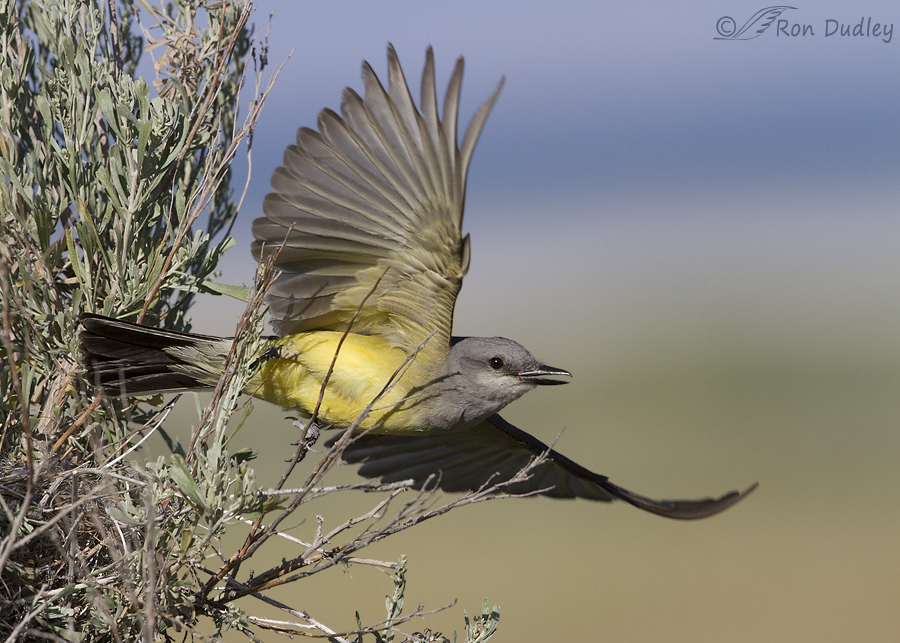Earlier this week I spent several mornings photographing a female Western Kingbird as she was constructing her nest. Out of the many hundreds of shots I took of her the third image in this post is my favorite. I include these first two photos only for context.

1/3200, f/5.6, ISO 800, Canon 7D, Canon EF500mm f/4L IS II USM, not baited, set up or called in
Here you see the nest at bottom It was partially buried in sagebrush and her access to it was from the north. She would fly in with nesting material, arrange it to her satisfaction for several minutes and then exit the nest unpredictably and explosively. At first my angle of view looked directly into the nest but while she was hunkered down in there she was too obscured for decent photographs and when she took off (as she’s doing here) I mostly got head-on shots with a very busy background so I soon changed my angle on the nest.
I include this image so you can see her only choice of egress – this opening to the north with a clump of living and dead sagebrush twigs (hereafter referred to as “the clump”) sticking up directly in front of her. She could launch to either side of it, over the top of it or split the difference. Partially depending on wind direction she did all three…

1/3200, f/8, ISO 500, Canon 7D, Canon EF500mm f/4L IS II USM, not baited, set up or called in
which meant that when I changed my shooting position to get a cleaner background and a side view of her takeoff I struggled to get her sharp because of depth of field issues. The DOF of my 500mm lens is very shallow and I had to pre-focus at the distance where I thought she might leave which might be to the left of the clump, to the right (less often) or over the top of it. In other words, it was a guessing game and I had to get lucky but when I finally had enough light (we started photographing just after dawn) to shoot at f/8 and still have a shutter speed of 1/3200 (which I prefer for small birds in flight) I had enough DOF to get both bird and sagebrush mostly sharp (I know that’s a lot of photography techno-speak but to photographers it’s important stuff…)
This image and the next one are sequential in a burst as she took off. She launched almost directly over the top of the clump and slightly to its left…

1/3200, f/8, ISO 500, Canon 7D, Canon EF500mm f/4L IS II USM, not baited, set up or called in
and timed it so that her right wing was in the up position as she passed it. My shutter clicked at just the right nanosecond and this was the result.
These are the things I like about the image:
-
the sharpness of the bird and most of the sagebrush
- the light under the body and right wing
- the open beak and good eye contact
- the composition
- the background appeals to me (Great Salt Lake and mud flats)
- good detail – the image is a small crop (82% of the original image)
True, there are some twigs in front of the bird but for my taste they contribute to the image as habitat and don’t significantly detract.
Ron
Note: Once again I want to stress the fact that we were very careful not to disturb or distress these birds (the male was always nearby) while she was building the nest. They are both acclimated to vehicles, we were shooting from my pickup, neither bird showed signs of nervousness and the nest-building was never interrupted by our presence. If it had been we’d have left immediately.


I can see why you like this image so much. The more I look at it, the better I like it. The composition is amazing, and I, too, like the twigs in front of the bird. I don’t have words to describe the way the twigs affect my perception of the photo; I just know that they add something very important to it.
Great captures!
Heart-opening! And thanks so much for sharing how you shoot in aperture priority with pre-selected ISO. Very helpful for us aspiring wildlife photographers!
They are all wonderful shots! Thanks for sharing!
Charlotte
Such a privilege to see. Thank you for your dedication, your skill, and your generous sharing of the magic. And magic it is.
Thank you, Elephants Child.
Wow! Great shots acquired by patience, perseverence, and excellent technique. I don’t think I have a take-off shot of a small bird nearly as good as these. Wiping my chin now.
Thanks very much, Dave.
Superb! Once again a graphic demonstration of how hard work, knowing your equipment, understanding the species and a lot of patience can produce outstanding results.
If you have time, Ron, a couple of technical questions. Do you typically shoot in aperture priority? Do you pre-select ISO or set a range for the camera to work with? Did you pre-focus on the twigs toward the front or rear of the bush or the edge of the nest location (or does it matter)?
Still trying to learn. Thank you!
Thank you, Wally. I always have time for questions here.
I always shoot in aperture priority – it’s just what I know best. I also always pre-select ISO. While I was shooting these shots I would pre-focus on different spots in the foliage, sometimes in front of the clump, sometimes in back and sometimes on the clump itself. I can’t remember what I did for this last shot though. When I was in lower light and had less DOF it mattered a lot where I pref-ocused and if I guessed wrong about where she came out she would be a little soft. It mattered less when I was able to go to f/8 and have more DOF (and maintain my 1/3200 SS).
Hope that answers your questions. If not, let me know…
Good morning, Ron, These are beautiful images…Each one is my “favorite” for different reasons…the composition, which seems to come so naturally with both you and Mis, is spot on…I love the wideA-spread wing, open beak and light in the eyes in the first, the raised foot in the second, and the third for all the same reasons you stated….beautiful!
Good morning to you too, Patty. And thank you.
The third shot really is outstanding.
Thanks, Arwen.
Amazing shots as always. The third image has everything. The sharpness of your photos is always right on!!!
Thanks, Ellen. Sharpness makes a lot of difference, doesn’t it?
As always, GREAT images, Ron!
Thanks very much, Wade.
Really love the last image Ron! The twig s and branches run almost parallel with right wing which ties it all together.
You’re right, I hadn’t noticed that, John. Thank you.